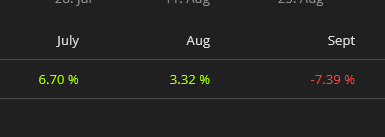AriaS
Well-known member
- Messages
- 369
- Likes
- 122
Have just seen that the Sharpe Ratio in May was 1.32. No wonder, since all the 27 trades were winners.
The strategy is now public on Myfxbook.
Btw, Myfxbook has malfunction. If your Sharpe Ratio shows 0.0, change the trading period by even one day (through “custom analysis”) and the Sharpe Ratio shows up.


The strategy is now public on Myfxbook.
Btw, Myfxbook has malfunction. If your Sharpe Ratio shows 0.0, change the trading period by even one day (through “custom analysis”) and the Sharpe Ratio shows up.

